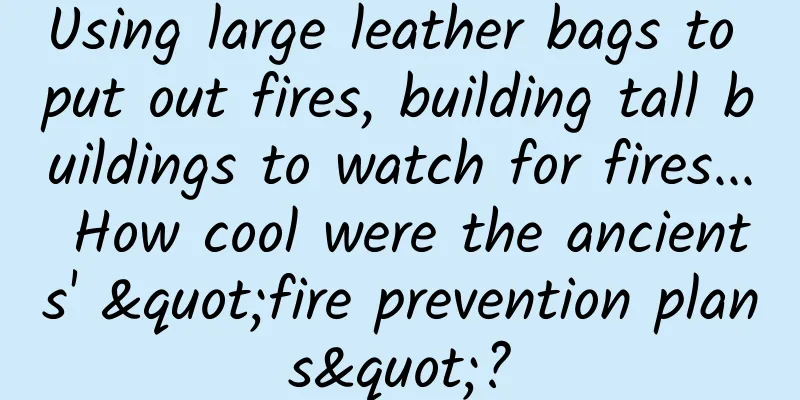Using large leather bags to put out fires, building tall buildings to watch for fires... How cool were the ancients' "fire prevention plans"?

|
Summer heat It is a high incidence period for various fire accidents. Fire safety is a top priority In the era when technology was not well developed The ancients used their great wisdom and creativity Actively explore ways to "tame" fire hazards Let’s talk about this issue Things about fire prevention and fire fighting in ancient times At the Dadiwan large-scale building site in Qin'an, Gansu, archaeologists discovered the remains of a fire that happened 5,000 years ago. A solid layer of fire-retardant coating was still preserved on the unburned wooden pillars, which means that the ancient ancestors had a strong awareness of fire prevention and had been exploring fire prevention technology very early on. Fire watchman "It's dry, be careful of fire", this is a classic line of the night watchman that we often see in TV dramas. The night watchman, as the name suggests, tells others the time by beating the night watch. In addition to telling the time, the night watchman also has another responsibility, which is to check the city's fire safety and avoid large-scale fires in the city. He can be called a fire alarm. The history of night watchmen can be traced back to the Zhou Dynasty. According to the book "Zhou Li", the earliest official in charge of fire safety in my country was "Si Xuan (xuǎn)" established during the Zhou Dynasty. The daily duties of "Si Xuan" were to patrol the streets and lighthouses of the city, and use a wooden hammer to knock on the bronze bell (duó) to remind people to pay attention to fire prevention. The early warning measures of "preventing troubles before they happen" have been passed down for thousands of years. The discussion of preventing troubles before they happen was first put forward in the Book of Changes. The Book of Changes, Part II, records: "Xiang says that water is above, and water is great. A gentleman should think about troubles and take precautions against them." Warring States period Image source: Palace Museum Fire Watching Station During the Han Dynasty, in addition to the night watchmen, there was a new fire prevention artifact, the Fire Watch Tower. We all know that climbing high can help us see far, and the Fire Watch Tower uses this principle. In the Han Dynasty, the Fire Watch Tower was four stories high. This height is not a big deal now, but in ancient times, houses often only had one or two floors. The four-story Fire Watch Tower can be said to be a place where you can see far from a height. The fire watchtower not only has the function of observation, but also has the functions of communication and command (in ancient times, there was no instant communication system. If a fire broke out, it was all spread by word of mouth. By the time rescue workers arrived, it would inevitably cause greater losses). In order to solve this problem, the fire watchtower was specially equipped with tools such as drums and flags. The drum sound could notify the people to escape and put out the fire, and the flags could better and orderly command the people to participate in the firefighting work. Therefore, the fire watchtower was a relatively effective fire prevention and early warning method in ancient times, and it could be regarded as the ancient "fire alarm". During the Western Han Dynasty, Chang'an Prefecture set up "a booth on each street", which is equivalent to today's fire alarm booth. During the Tang Dynasty, Chang'an built "Wuhoupu" to take into account the public security and fire protection in Chang'an City. According to the "New Book of Tang Dynasty•Baiguanzhi", there were "Wuhoupu" of different sizes in various places throughout the city, forming a public security and fire protection network system. The building in the "Along the River During the Qingming Festival" below is the "fire watchtower" specially set up in Song Dynasty cities to detect fires in a timely manner. Along the River During the Qingming Festival, Northern Song Dynasty Image source: Palace Museum Fire extinguisher bag During the Tang Dynasty, the government organized a firefighting organization specializing in firefighting and called it "Wu Hou Pu". At that time, "Wu Hou Pu" were mainly found in large cities such as Chang'an and Luoyang, and they were usually distributed in various markets and alleys. In addition to staffing, "Wu Hou Pu" also began to use some effective firefighting tools. Since the Tang Dynasty, firefighting has been done with leather bags and splash barrels. The so-called leather bag is a water-filled tool made of animal skin, and the splash barrel is more advanced. According to the Tang Dynasty book "Tongdian", "If the enemy sets fire to the battlements, use a thick bamboo ten feet long, cut off the nodes, and sew it with raw thin skin to make a bag, store three or four stones of water, put the barrel in the bag, and quickly tie it like a splash barrel." In simple terms, a bamboo tube is inserted into a water-filled belt and then sealed. When extinguishing a fire, squeeze the leather bag hard and water will spray out of the bamboo tube. Does it look familiar? Yes, it is a bit similar to a modern high-pressure water gun. During the Song Dynasty, the firefighting team was upgraded on the basis of the Tang Dynasty. The world's earliest professional firefighting organization, the "submarine fire brigade", was established. The "submarine fire brigade" of the Song Dynasty was equipped with the most advanced firefighting equipment in the world at that time, such as fire prevention equipment, barrel ropes, flags, axes and saws, lanterns, fire vests and other equipment, all of which were funded by the government. In addition, it was also equipped with relatively modern equipment, such as ladders, which could be used to fight fires in high-rise buildings. The "Wujing Zongyao" of the Northern Song Dynasty recorded four pieces of fire-fighting equipment at that time. Firefighting equipment recorded in Wujing Zongyao Image source: China Red Scarf Water bag: Made of horse or cow skin, it can hold 300 to 400 kilograms of water. Tie the bag tightly and insert a bamboo tube into it, which can be used to pour water into the fire. Water bag: Made of pig or cow bladder membrane, fill it with water and tie it tightly. Throw the water bag onto the fire. When the water bag is burned, the water will flow out to extinguish the fire. Hemp tether: Loose hemp is tied to the top of a long pole, which can be used to put out fire after being dipped in mud and water. Pump: It is like an oversized bamboo "water gun" used to spray water to extinguish fire. Fire-resistant building materials In ancient times, houses were almost all made of wood, so fires were very common at that time. In order to prevent fires, the ancients began to study fire-proof materials while building houses. Glazed tiles became an important material for promoting fire prevention in ancient times. It was very common to use glazed tiles on roofs, and they were widely used in places that required fire prevention, such as palaces, temples, schools, shops, etc. For example, glazed tiles were widely used in the buildings of the Forbidden City, and were known as the "fireproof tiles" of the Forbidden City. Glazed tiles are made of glazed clay and then fired on red pottery. The surface is covered with a thin layer of glazed glaze. The color is bright and the gloss is high. They are known as "tiles of wealth". Moreover, it is heavier than ordinary tiles, not easily blown down by the wind, and has good wind resistance; heat treatment can increase its hardness and durability, and its service life is longer than that of ordinary tiles; in addition, it can also play a role in sound insulation and heat preservation. The right side of the picture shows a fragment of glazed tiles, and the left side shows a glazed animal head Image source: China Fire | China Fire Museum Fire extinguishing cylinder Visitors to the Forbidden City are often attracted by the oversized copper water tanks at the entrances of some palaces. These are Taiping tanks, which play an important role in firefighting. They are also called "menhai", which means "sea in front of the gate". According to the "Da Qing Hui Dian", there were 308 Taiping tanks in the Forbidden City during its heyday. Among them, the largest one is the gilded copper one, with a diameter of 1.6 meters, a height of 1.2 meters, and a weight of more than 3,000 kilograms. It can hold 2,000 liters of water, which is more than the water storage capacity of a modern fire truck. These "peace jars" were set up on stone circles, which were hearths with stone doors. In winter, people would burn charcoal in the stone circles to heat the bottom of the jars to prevent the water inside from freezing, truly being prepared for any eventuality. The Forbidden City Gilded Taiping Bronze Vase Image source: CCTV News | Hubei Emergency Management Fire-proof horse head wall Most of the ancient Chinese buildings were made of wood. In order to avoid "fire burning the entire camp", the clever ancients thought of using walls to separate the fire source. Among them, the most distinctive is the horse head wall. The horse head wall is also called the wind and fire wall, the fire-sealing wall, the fire-setting wall, etc. It is an important feature of the Gan style architecture and the Hui style architecture (Huizhou architecture) of the traditional Han residential architecture. It specifically refers to the wall that is higher than the roof of the two gables, that is, the top part of the gable. Because of its shape that resembles a horse head, it is called the "horse head wall". It is a wall structure for the purpose of fire prevention in traditional Chinese residential settlements. During the Hongzhi reign of the Ming Dynasty, fires frequently occurred in Huizhou City. The Huizhou governor He Xin organized people to build horse-head walls with bricks as fire walls. They are windproof and fireproof, and can effectively isolate the source of fire and prevent the spread of fire in densely populated residential areas. From the ancients' fire prevention wisdom We can get a glimpse of the prototype of modern firefighting technology Today Pay attention to fire prevention is still A compulsory course for people to protect their own safety Summer heat A large increase in the use of fire and electricity I hope everyone pays attention to fire and electricity safety Prevent problems before they happen Sources: China Fire, China Fire Museum, Beijing Fire, Ministry of Emergency Management, Central Commission for Discipline Inspection and National Supervisory Commission, Xinhua News Agency, People's Information, Elephant News, CCTV News, Hubei Emergency Management, China Red Scarf, Image sources: China Fire, China Fire Museum, China Red Scarf, CCTV News, Hubei Emergency Management, Palace Museum Source: Chongqing Jiulongpo District Cultural Relics Management Office Audit expert: Li Xiaoying Statement: Except for original content and special notes, some pictures are from the Internet. They are not for commercial purposes and are only used as popular science materials. The copyright belongs to the original authors. If there is any infringement, please contact us to delete them. |
<<: Is it so easy to make your own wine? Be careful, beware of methanol poisoning...
Recommend
World Hypertension Day | If blood pressure drops, can you stop taking medication? 10 myths about hypertension are dispelled today
Hypertension is a common and frequently occurring...
A collection of copywriting works taking advantage of Thanksgiving is freshly released, and a large number of copywriting works are heartwarming and comforting!
Thanksgiving Day originally refers to an ancient ...
JATO Dynamics: Global car sales in March 2020 totaled 5.55 million units, down 39% year-on-year
According to data from automotive data analysis c...
How to effectively promote WeChat Moments?
In an era when mobile social applications are all...
Feng Shui doesn't require help from others, Guannan teaches you how to calculate Feng Shui
Album Introduction If you are—— ◎The newly marrie...
22 lectures on software architecture scenarios, essential practical experience from engineers to architects
22 lectures on practical software architecture sce...
Comparison of Flutter and React Native for mobile development
【51CTO.com Quick Translation】Just a few years ago...
Server Hosting Transfer Notes
Server Hosting Transfer Notes 1. Debug website pr...
Optimization techniques and advantages of splash screen ads!
Whether it is a general giant APP or a specific v...
Get started with information flow advertising!
For more basic knowledge about information flow a...
Meizu needs to change its marketing model before it can imitate Xiaomi
Xiaomi's phenomenal growth over the past few ...
Well-known female star becomes "Electronic Dora"! What is the reason for incomplete glottal closure?
Recently, #秦岚声带难过# has become a hot search topic,...
Xiaohongshu Enterprise Account Operation Strategy!
01 Confusion in the operation of Xiaohongshu corp...
Having good games is not enough: Reasons why independent developers fail in review
For independent developers, it is becoming increa...
How to quickly start a product promotion IP on Zhihu?
I have been operating the Zhihu live streaming p...









